Introduction
Since its introduction in the middle of Gwent Masters 2, the LEI = Ladder Efficiency Index became household for describing Gwent players MMR vs games efficiency on Gwent Pro Ladder. It brought some spice to Pro Ladder competition and gave another field to compare scores with other players. LEI/LEI4 columns are right now integral part of leaderboard presented on GwentData.
The concept was further generalized on factional scores (fLEIs) and you could find most efficient faction scores on Highscores page for Masters 4 and Masters 5.
In this article we would investigate some basic LEI properties, also making use of elo paths simulation to answer the question of how many games should be played to maximize LEI.
Expressions
Ladder Efficiency Index (LEI)
\[LEI = \frac{MMR-9600}{\sqrt{GAMES}}\]
Factional Ladder Efficiency Index (fLEI)
\[fLEI = 2 \frac{fMMR-2400}{\sqrt{fGAMES}}\]
Why Square Root?
The most straightforward approach to measure efficiency is to count mmr per game. Obviously 9600 (base, guaranteed mmr) has to be the reference point, so we get:
\[Eff = \frac{MMR-9600}{GAMES}\]
Eff is direct efficiency parameter with a simple interpretation. Why to define LEI instead and square root the number of games then? The reason is that the higher MMR is, the more games are needed to improve. In fact what we do in LEI is squaring MMR surplus in Eff and then taking a square root of whole fraction to get smaller, neat number.
\[LEI = \sqrt{\frac{(MMR-9600)^2}{GAMES}}\]
Why square and not cube root then? Well, there is no answer to this question other than LEI working in satisfying enough way, while cube root having too high nerd factor.
As we can see in the chart above, Eff is hardly a good measure of real ladder efficiency when it comes to competitive play. None of the top scores was at Top64 level, let alone Top10. All scores are just finished good placements to secure Top500 position (not even the best, as players putting them up would usually play on and drop out of the chart) That’s why we need LEI instead of Eff as a kickass meter.
LEI Cube underlines high MMR scores better than normal LEI and is perhaps closer to justice. Nevertheless, 100+ numbers are less friendly for viewers and it is harder to link LEI Cube with number of games milestones using naked eye.
LEI Milestones
To hands-on check out how good scores at various LEI level are, we could use 100 and 400 games milestones. Those numbers are easy to take root from: we get 10 and 20 respectively. To get LEI then we simply divide surplus MMR by 10 or 20. Have a look at Ladik score a the top of Eff Highscores for a demo.
30 LEI = 9.9k MMR in 100 games = 10.2k MMR in 400 games
40 LEI = 10k MMR in 100 games = 10.4k MMR in 400 games
50 LEI = 10.1k MMR in 100 games = 10.6k MMR in 400 games
To keep LEI from placements, you have to gain same amount of MMR in the following 300 games.
Is LEI a meter of Gwent skill?
Yes and not. The main meter is always MMR especially when it comes to top competitive level (like Top3 places on ladder). Trust it or not, the impact of heavy grind is much lower amongst the top, because ‘random walk’ is not sufficient to climb (have a look at ‘ladder monkey’ study).
LEI is also a measure of attitude. ‘Memers’ or ‘Jammers’ just liking to play the game would have lower LEI than players going for certain rating in least possible time.
What is sure is that players with high (40+) LEI are good for ladder standards, especially if they could repeat such scores in multiple seasons. If they finish just in Top500 region rather than fight for top spots, LEI is a better indicator of skill than MMR, basically saying that scores achieved by a player are not saturated yet and they could finish much higher if tryharding.
How To Maximize LEI?
The practical advice could be found in Gwentfinity Contest article in 60 LEI section.
Here we would make an abstract study: assuming various skill (=ELO=fMMR) levels, how does LEI evolve with number of games and what LEI scores would be achieved on average? To answer these questions, I have done Markov Chain simulation as described in elo paths article.
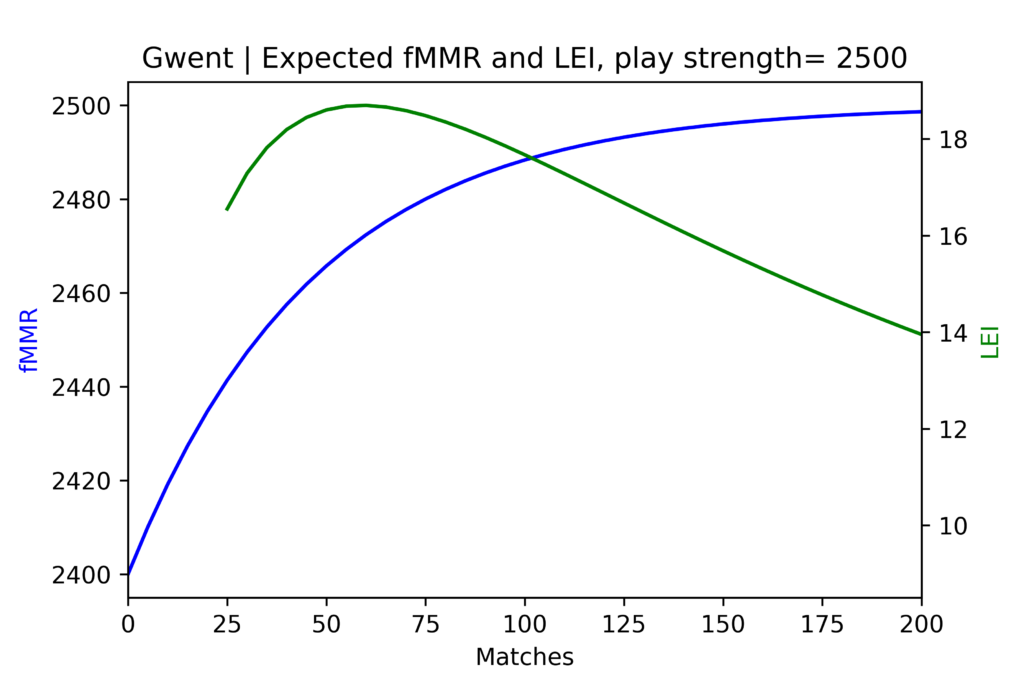
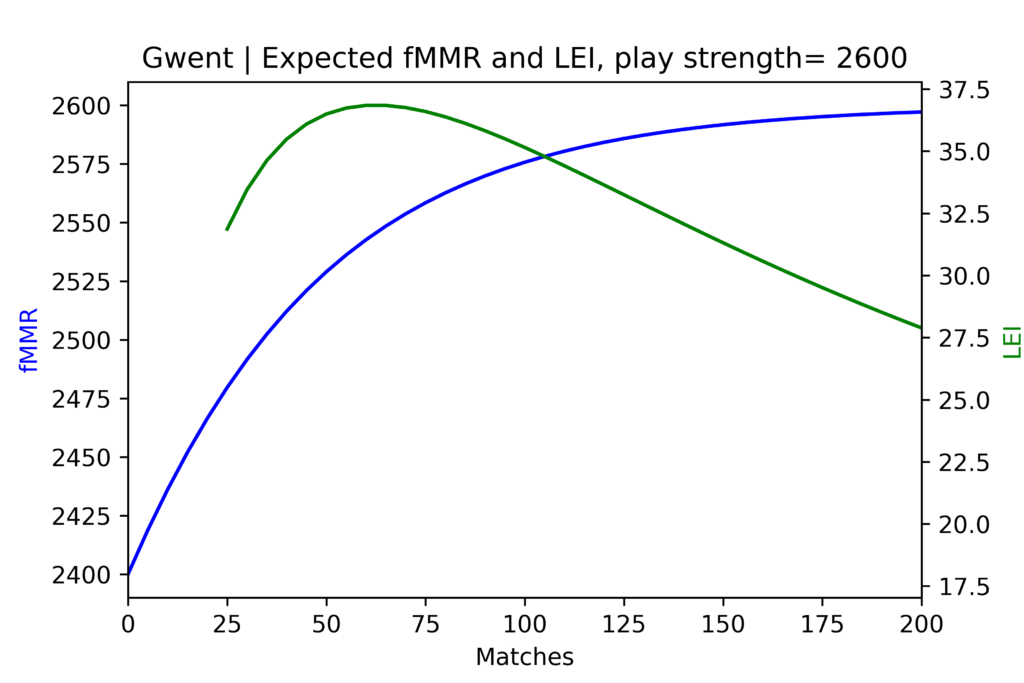
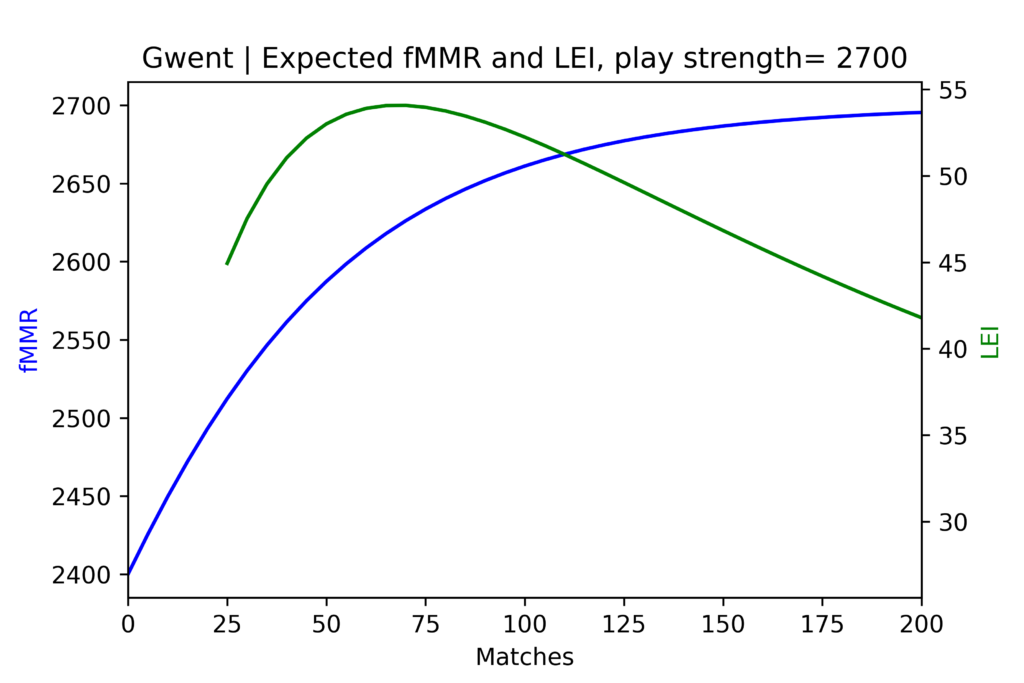
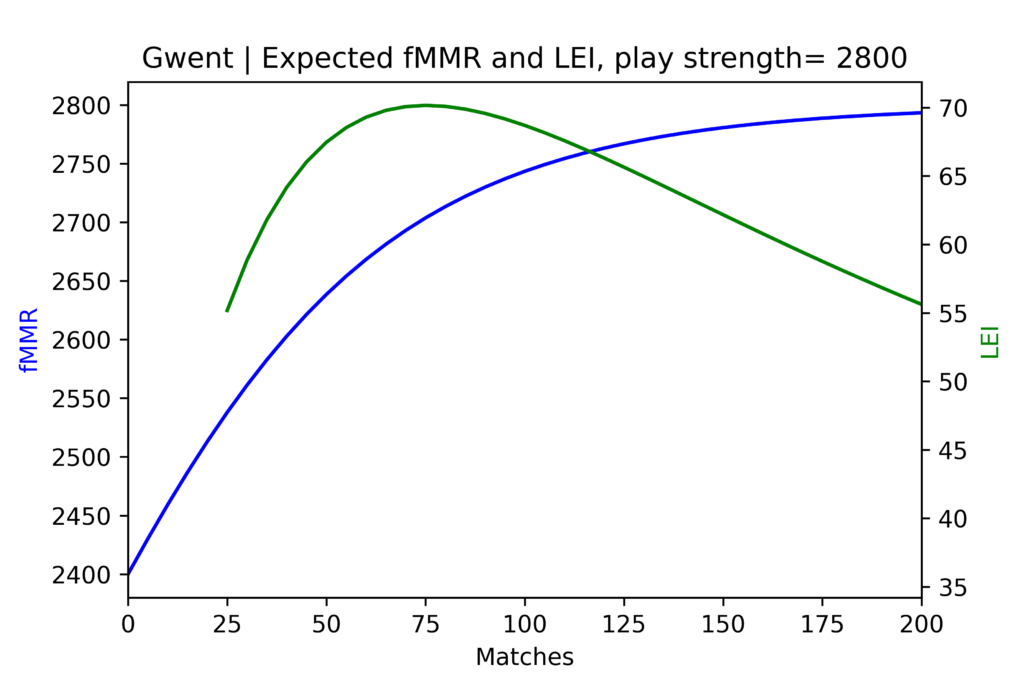
No matter the play strength, the shapes are very similar. 50-100 games per faction (200-400 games in total) is the optimal number to repeatedly get high LEI. Have a look at the table from the original article to see how Top8 TailBot/Kolemoen scores were exactly in this region, while no worse Demarcation achievements got punished for exceeding 400 games mark
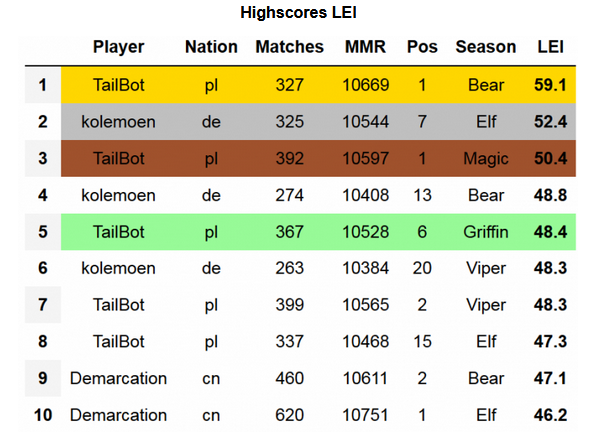
Let’s see how exactly optimal number of games and peak LEI evolves with skill in this simple model:
To repeatedly achieve high LEI, one has to be a really skillful player, with Top16 potential. There is no shortcuts. Best LEI value is achieved at about 70-75% of potential fMMR; final grind to real skill level usually lowers LEI. Have a look at how best LEI scores of season winners were done when they got significant advantage over runner-up: TailBot in March Season of Masters 2 with 58 points lead; Pajabol in May of Masters 3 with 90 points ahead; finally in the just finished February Season of Masters 5: 105 points over Redrame. Therefore, final grind at the saturation level wasn’t needed and they could finish play just when losing the last peak.
Closure
Hope you enjoyed this LEI detour and learned more about its underlying logic. Gwent: The Witcher Card Game may die in a year, but understanding will remain and the topic of efficiency is really universal.
Also, LEI Caluculator got added to website, including fLEI.
Stay tuned!

